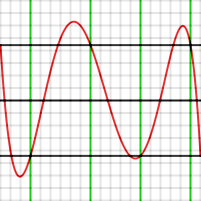Applications of Mathematics in Computer Science (MACS)
Approximating library functions
Concepts:
- analytic functions;
- Taylor series;
- Remez algorithm.
Library of mathematical functions
https://docs.python.org/3/library/math.html
- Number-theoretic and representation functions
- Power and logarithmic functions
- Angular conversions
- Trigonometric functions
- Hyperbolic functions
- Special functions
- Constants
Uses of functions
| power and logarithmic | efficient computation, data analysis |
| trigonometric | physics, machine learning, time series |
| hyperbolic | physics, machine learning, time series |
| special functions | statistics, machine learning |
Usage examples
- log — decision trees (machine learning)
- tanh — REINFORCE algorithm (planning)
- erf — materials discovery and design (statistical modeling)
Computing mathematical functions
Example: sin and cos, in Go.
var _cos = [...]float64{
-1.13585365213876817300e-11, // 0xbda8fa49a0861a9b
2.08757008419747316778e-9, // 0x3e21ee9d7b4e3f05
-2.75573141792967388112e-7, // 0xbe927e4f7eac4bc6
2.48015872888517045348e-5, // 0x3efa01a019c844f5
-1.38888888888730564116e-3, // 0xbf56c16c16c14f91
4.16666666666665929218e-2, // 0x3fa555555555554b
}
func Cos(x float64) float64 {
const (
PI4A = 7.85398125648498535156e-1 // 0x3fe921fb40000000, Pi/4 split into three parts
PI4B = 3.77489470793079817668e-8 // 0x3e64442d00000000,
PI4C = 2.69515142907905952645e-15 // 0x3ce8469898cc5170,
)
// special cases
switch {
case IsNaN(x) || IsInf(x, 0):
return NaN()
}
// make argument positive
sign := false
x = Abs(x)
var j uint64
var y, z float64
if x >= reduceThreshold {
j, z = trigReduce(x)
} else {
j = uint64(x * (4 / Pi)) // integer part of x/(Pi/4), as integer for tests on the phase angle
y = float64(j) // integer part of x/(Pi/4), as float
// map zeros to origin
if j&1 == 1 {
j++
y++
}
j &= 7 // octant modulo 2Pi radians (360 degrees)
z = ((x - y*PI4A) - y*PI4B) - y*PI4C // Extended precision modular arithmetic
}
if j > 3 {
j -= 4
sign = !sign
}
if j > 1 {
sign = !sign
}
zz := z * z
if j == 1 || j == 2 {
y = z + z*zz*((((((_sin[0]*zz)+_sin[1])*zz+_sin[2])*zz+_sin[3])*zz+_sin[4])*zz+_sin[5])
} else {
y = 1.0 - 0.5*zz + zz*zz*((((((_cos[0]*zz)+_cos[1])*zz+_cos[2])*zz+_cos[3])*zz+_cos[4])*zz+_cos[5])
}
if sign {
y = -y
}
return y
}
Approximation theory
- Polynomials
- Analytic functions
- Taylor series
- Remez algorithm
Polynomials
- Polynomial: $p(x) = \sum_{i=0}^N a_i x^i$
- Polynomials ar easy to compute:
def poly(x, aa): xi, v = 1, 0 for a in aa: v += a*xi xi *= x return v - Sum and product of polynomials are polynomials
- Ratios of polynomials are also easy to compute
- $N=\infty$ ⇒ power series: $\sum_{i=0}^\infty a_i x^i$
Analytic functions
Function $f(x)$ is analytic if for any $x_0 \in D$: $$f(x) = \sum_{i=0}^\infty a_i (x-x_0)^i$$.
- $f(x)$ is analytic if can be computed as a power series.
- Polynomials are analytic.
- We can approximate $f(x) \approx \sum_{i=0}^N a_i (x-x_0)^i$, because if $|x-x_0|<1$, $\lim_{n\to\infty} (x-x_0)^n = 0$.
Examples of analytic functions
- $\exp(x) = \sum_{i=0}^\infty \frac {x^i} {i!}$
- $\ln (x) = \sum_{i=1}^\infty (-1)^{i+1}\frac{(x-1)^i}{i}$ for $0 < x < 2$
- $\sin(x) = \sum_{i=0}^\infty \frac {(-1)^i} {(2i+1)!}x^{2i+1}$
These are Taylor series!
Taylor series
If $f(x)$ is infinitely differentiable, then $$\mathrm{Taylor}(f(x), a) = \sum_{i=0}^\infty \frac {f^{(i)}(a)} {i!} (x-a)^i$$ at point $a$.
- Taylor series of a polynomial is the polynomial.
- For most functions, $f(x) = \mathrm{Taylor}(f(x), a)$ for some $a$.
- If $f(x) = \mathrm{Taylor}(f(x), a)$ for any $a$, the function is entire
Taylor series of exp(x)
- Which $N$ to take?
- What is the error?
- $|\mathrm{Taylor}_4(exp(2), 0)-exp(2)|\approx 0.002$
- $|\mathrm{Taylor}_4(exp(4), 0)-exp(4)|\approx 1.2$
Remez algorithm

- Find optimal polynomial: $P(x)$, for $x_1, x_2, ..., x_{N+2}$: $$P(x_1) - f(x_1) = +\varepsilon$$ $$P(x_2) - f(x_2) = -\varepsilon$$ $$...$$
- Move $x_i$ such that error $\le \varepsilon$ for any $x_1 \le x \le x_{N+2}$